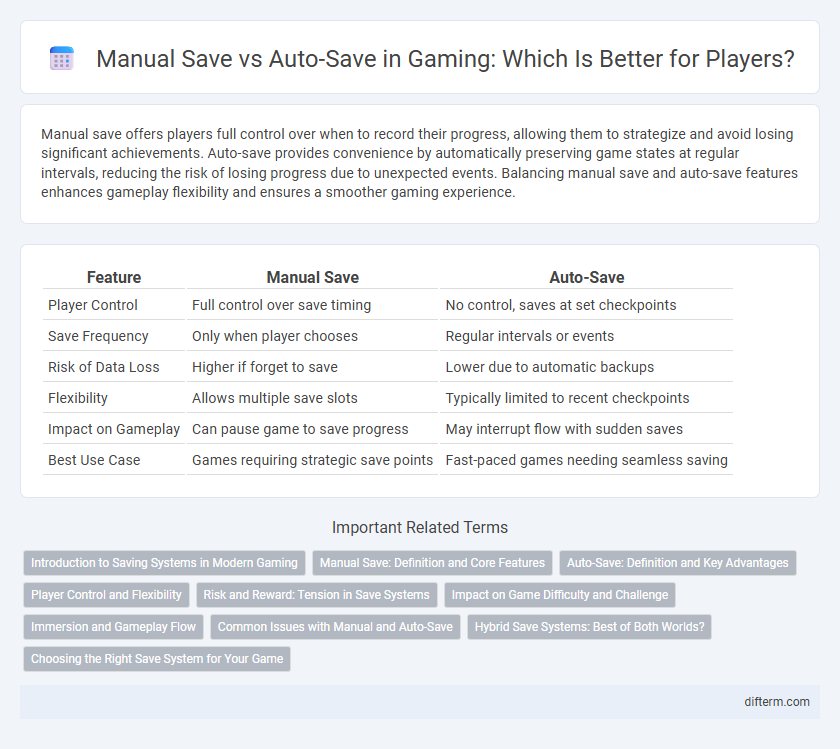Manual save offers players full control over when to record their progress, allowing them to strategize and avoid losing significant achievements. Auto-save provides convenience by automatically preserving game states at regular intervals, reducing the risk of losing progress due to unexpected events. Balancing manual save and auto-save features enhances gameplay flexibility and ensures a smoother gaming experience.
Table of Comparison
| Feature | Manual Save | Auto-Save |
|---|---|---|
| Player Control | Full control over save timing | No control, saves at set checkpoints |
| Save Frequency | Only when player chooses | Regular intervals or events |
| Risk of Data Loss | Higher if forget to save | Lower due to automatic backups |
| Flexibility | Allows multiple save slots | Typically limited to recent checkpoints |
| Impact on Gameplay | Can pause game to save progress | May interrupt flow with sudden saves |
| Best Use Case | Games requiring strategic save points | Fast-paced games needing seamless saving |
Introduction to Saving Systems in Modern Gaming
Modern gaming incorporates both manual save and auto-save systems to enhance player experience and data security. Manual saving allows players to control progress checkpoints, offering flexibility and strategic planning, while auto-save continuously records game state to prevent data loss and reduce frustration during unexpected interruptions. The combination of these saving systems balances player agency with reliability, optimizing gameplay flow and user satisfaction.
Manual Save: Definition and Core Features
Manual save allows players to control when and where their game progress is recorded, offering precise checkpoints tailored to individual playstyles. Core features include the ability to create multiple save files, enabling experimentation without the risk of losing progress and providing a safety net before challenging segments. This system enhances strategic decision-making, as players can choose optimal moments to save and reload, fostering a customized gaming experience.
Auto-Save: Definition and Key Advantages
Auto-save is a feature in gaming that automatically records player progress at specific intervals or checkpoints, minimizing the risk of data loss during unexpected interruptions. This system enhances player experience by providing seamless continuity without requiring manual intervention, reducing frustration caused by forgetting to save. Key advantages include increased convenience, protection against crashes, and a smoother gameplay flow, especially in complex or lengthy games.
Player Control and Flexibility
Manual save empowers players with full control over their gaming progress, allowing them to strategically choose when and where to save, thereby reducing frustration from unforeseen setbacks. Auto-save offers convenience by automatically preserving progress, but it can limit flexibility by forcing players to rely on predetermined save points. Balancing manual and auto-save systems caters to varied player preferences, enhancing overall gameplay satisfaction and control.
Risk and Reward: Tension in Save Systems
Manual save systems heighten tension by requiring players to strategically decide when to record progress, risking significant loss if overlooked. Auto-save reduces anxiety by continuously preserving game state but may diminish the thrill and consequence of failure. Balancing these systems influences player engagement, with manual saves fostering risk-reward dynamics and auto-saves promoting seamless experience continuity.
Impact on Game Difficulty and Challenge
Manual save systems increase game difficulty by requiring strategic decision-making about when to save progress, intensifying the challenge and risk of losing achievements. Auto-save features reduce frustration by minimizing repeated tasks after failure but can diminish the sense of accomplishment and tension. Balancing these save mechanics influences player engagement and overall game difficulty perception.
Immersion and Gameplay Flow
Manual save systems empower players with control over when to preserve progress, enhancing immersion by allowing strategic pauses that align with narrative or gameplay milestones. Auto-save mechanisms maintain seamless gameplay flow by automatically recording progress at critical moments, reducing frustration from lost data but potentially disrupting immersion during unanticipated save triggers. Balancing manual and auto-save features can optimize player engagement, ensuring fluid experiences while respecting the immersive integrity of the game world.
Common Issues with Manual and Auto-Save
Manual save systems in gaming often lead to data loss when players forget to save progress or experience unexpected crashes, resulting in frustration and lost achievements. Auto-save features can create issues such as saving at inopportune moments, preventing players from retrying difficult sections or making strategic resets. Both save methods require careful balancing to minimize risks of corrupted files, save glitches, and interruptions to gameplay flow.
Hybrid Save Systems: Best of Both Worlds?
Hybrid save systems combine the control of manual saves with the convenience of auto-saves, providing gamers flexibility and reducing frustration from lost progress. By integrating checkpoint-based auto-saves with optional manual save slots, these systems optimize gameplay flow and minimize disruptions. This approach enhances player experience by balancing freedom and security, appealing to diverse gaming styles and improving overall game engagement.
Choosing the Right Save System for Your Game
Selecting the appropriate save system depends on balancing player agency and convenience within your game design. Manual save systems offer players control over progress, enhancing strategic planning and reducing frustration from unwanted checkpoints. Auto-save systems improve immersion by seamlessly preserving progress, but risk overwriting important moments without player consent, so evaluating game length and difficulty is crucial for optimal implementation.
manual save vs auto-save Infographic

 difterm.com
difterm.com